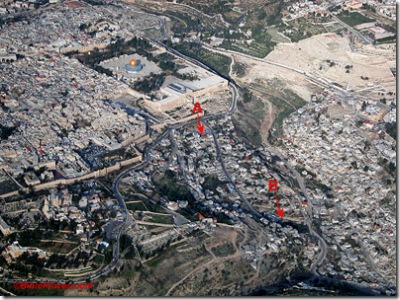Joseph Lauer sent along a list of recent articles describing the on-going destruction of antiquities on the Temple Mount. That list is below. The one I want to highlight is the report by Zachi Zweig on the BAR website. Those interested in the more technical aspects of what exactly is being found/destroyed will appreciate the detailed information, photos, and the link to a video Zweig took.
For those who don’t know, Zweig is the one who initiated the rescue dig of the Temple Mount debris dumped in the late 1990s (under the direction of G. Barkay). These are sad days for those who love Jerusalem and the Temple Mount.
Other links include:
http://www.israelnationalnews.com/News/News.aspx/123525
Arutz Sheva – IsraelNationalNews.com
Wednesday, August 29, 2007
Policeman Assaulted Trying to Stop Illegal Temple Mount Dig
http://www.israelnationalnews.com/News/News.aspx/123539
Arutz Sheva – IsraelNationalNews.com
Thursday, August 30, 2007
Archaeologists Issue Urgent Warnings Against Temple Mount Dig A video of the excavation by a
tractor is available at the Arutz Sheva site.
http://urltea.com/1f7j
http://urltea.com/1f7i
The Jerusalem Post Online Edition
Friday, August 31, 2007 0:23 – Updated Aug 31, 2007 0:23
Archaeologists: Muslim dig damaged Temple wall
http://afp.google.com/article/ALeqM5iUzxureMd9FeVLdn7COA01N4HFBA
AFP [c. Friday, 8/31/07]
Doubts over ‘second temple remains’ in Jerusalem
http://www.haaretz.com/hasen/pages/ShArt.jhtml?itemNo=899374 [English]
http://www.haaretz.co.il/hasite/pages/ShArt.jhtml?itemNo=899498 [Hebrew, with pictures and
captions]
http://www.haaretz.co.il/hasite/pages/ShArt.jhtml?itemNo=899499 [Hebrew, the section concerning
the new artifacts discovered in sifting through earth removed from the Temple Mount] Ha’aretz
English Language Edition Friday, August 31, 2007 (Last update – 11:28 31/08/2007)
Archaeologists: Waqf dig endangering relics that may have been part of Temple
http://ap.google.com/article/ALeqM5gltAsV6Z1vF8YKN-psJTduQT9ZrQ
The Associated Press [c. Saturday, 9/1/07] Jerusalem Holy Site Dig Questioned There are seven
enlargeable pictures (with captions) at the site.
http://voanews.com/english/2007-09-01-voa10.cfm
The Voice of America
Saturday, September 1, 2007
Israeli Archaeologists Say Muslims Damaged Relics at Jerusalem Holy Site Robert Berger’s report
can be heard (and downloaded) at http://urltea.com/1f7h and both can be clicked on at the VOA site.
http://www.wnd.com/news/article.asp?ARTICLE_ID=57445
WorldNetDaily
Sunday, September 2, 2007
Muslims caught red-handed destroying Temple artifacts Archaeologists kept out as WND obtains
photo of pulverized antiquities at Judaism’s holiest site
http://www.israelnationalnews.com/News/News.aspx/123575
Arutz Sheva – IsraelNationalNews.com
Monday, September 3, 2007
Remnants of the Second Temple Being Destroyed by Islamic Wakf A video of the excavation by a
tractor and a still picture are available at the Arutz Sheva site.
http://www.wnd.com/news/article.asp?ARTICLE_ID=57507
WorldNetDaily
Thursday, September 6, 2007
Muslims bar WND from Temple dig
Archaeologists kept out as Islamic custodians pulverize antiquities A video of WND’s Aaron Klein
being barred from the trench site on the Temple Mount may be viewed at http://urltea.com/1f7g
